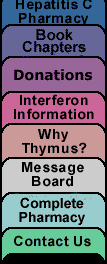| By
Russell L. Blaylock, M.D.
Interferons are used in clinical
medicine
for a number of medical conditions including:
 A
wide range of cancers A
wide range of cancers
 Chronic
hepatitis Chronic
hepatitis
 Multiple
sclerosis Multiple
sclerosis
 Chronic
granulomatous disease Chronic
granulomatous disease
 AIDS-related
disorders AIDS-related
disorders
Rarely considered are the effects of
large doses of this immune cytokine on
brain function. For example, the conventional
treatment of chronic hepatitis is interferon-alpha-2b.
Despite poor results in controlling the
disease and the existence of safer, more
effective natural treatments, physicians
continue to use this toxic treatment.
Of major concern are the neurologic effects
of the treatment.
It is known that interferons have two
patterns of injury to the brain. One is
acute and occurs within hours of treatment,
often lasting for the first one to three
weeks of the treatment. This usually includes
fever, chills, headache and fatigue.
This is followed by a chronic phase in
which more serious injuries to the nervous
system result. Chronic symptoms can include
malaise, lethargy, somnolence, headaches,
low-grade fevers, anorexia (loss of appetite)
and more serious symptoms such as psychomotor
symptoms, cognitive problems, psychiatric
behaviors and even delirium and coma.
The severity of symptoms depends on the
dose of the interferon and manner of administering
the medication. Continuous infusion of
high-dose interferons is associated with
more severe neurologic problems. It is
known that chronic brain toxicities occur
at all doses but more so after doses higher
than 18 million to 20 million units a
day. Most common is severe fatigue.
Even lower doses have been associated
with a lack of drive and disinterest in
participating in normal activities, a
process called psychomotor retardation.
This occurs in anywhere from 47 percent
to 80 percent of patients. Changes in
the ability to think clearly (cognitive
changes) are frequently seen in patients
treated with as little as 9 million units
of interferon per week. The difficulty
with thinking reaches a peak at one to
three months. This can include a decreased
attention span, difficulty concentrating,
defective short-term memory and mental
clouding.
Studies have described frequent periods
of silence and vacant staring, occurring
even in mid-sentence. Objective testing
for recall and cognitive function have
shown an incidence of 17 percent to 50
percent in patients receiving standard
doses of interferons. Most of these cognitive
difficulties do improve, yet there are
reports of persistent impairments lasting
up to two years following cessation of
treatment.
In some patients the effect is so severe
on the brain that patients sleep up to
20 hours a day and during waking periods
experience disorientation and confusion.
Speech difficulties (expressive dysphasia)
and problems with balance have also been
reported. On rare instances, these neurological
effects have progressed to a demented
state. Hallucinations have also been reported.
It is important to appreciate that the
patients in the first two categories to
be described had no previous psychiatric
history. Renault and co-workers, who examined
many of these patients, divided the neurobehavioral
effects into three syndromes: organic
personality syndrome, organic affective
syndrome and delirium effects. Patients
with organic personality syndrome frequently
experience uncontrollable overreaction
to minor frustrations, are very irritable
and have a short temper.
Those with the organic affective syndrome
often describe feelings of depression
and hopelessness. They cry easily and
have difficulty interacting socially with
others. Patients experiencing delirium
have a clouding of their thinking, have
short-term memory problems and have frequent
mood changes. Many become severely agitated,
abusive, withdrawn and may exhibit suicidal
thoughts, delusions of being persecuted
and phobias. Patients having delirium
symptoms often had co-existing liver disease,
history of psychiatric disorder or previous
brain injury.
The most severe effects have been seen
in patients treated for cancers. In these
patients death due to encephalopathy (widespread
brain injury) and associated seizures
have been described. This may be a result
of combined toxicities of radiation, chemotherapy
and interferon.
Interferon-gamma is less toxic than the
alpha or beta-interferons. With higher
doses one can see chronic neurotoxicities,
which can include dizziness, slowed thinking,
confusion, crying spells, and even symptoms
resembling Parkinson's disease.
The mechanism of this injury to the brain
appears to involve the brain's special
immune cell called the microglia. Normally,
these cells remain dormant in the brain.
That is, they are sleeping. Microglia
cells can be activated by numerous factors,
including mercury, aluminum, iron, overvaccination,
and brain trauma, strokes, infections
(viruses, bacteria, rickettsia) and cytokines
such as interferons.
Once activated, microglia can move about
the brain secreting very toxic compounds,
which include two excitotoxins (glutamate
and quinolinic acid). These excitotoxins
dramatically increase free radical generation
in the brain as well as oxidation of lipids
(called lipid peroxidation). These radicals
damage synaptic connections, interfere
with neurotransmitters and can even kill
neurons. In addition, these activated
microglia generate other toxic compounds
such as prostaglandins (PGE2), which increase
brain inflammation.
If the microglia activation is short
lived, the damage to the brain is minimal
and recovery takes place. Yet, should
the activation continue, which would occur
with high-dose and long-term use of interferons,
the damage could be substantial and irreversible.
Protecting the brain with high-dose and
varied antioxidants as well as certain
metabolic stimulants can substantially
reduce this damage. Certain nutrients,
such as malate, pyruvate, DHA, ascorbate,
magnesium and methylcobalamin inhibit
excitotoxicity.
Physicians often ignore patient complaints
of neurological difficulties during interferon
treatments, assuming they are benign and
reversible. As stated in the beginning,
natural alternatives have been shown to
be much more effective and dramatically
safer than interferon treatments.
|


